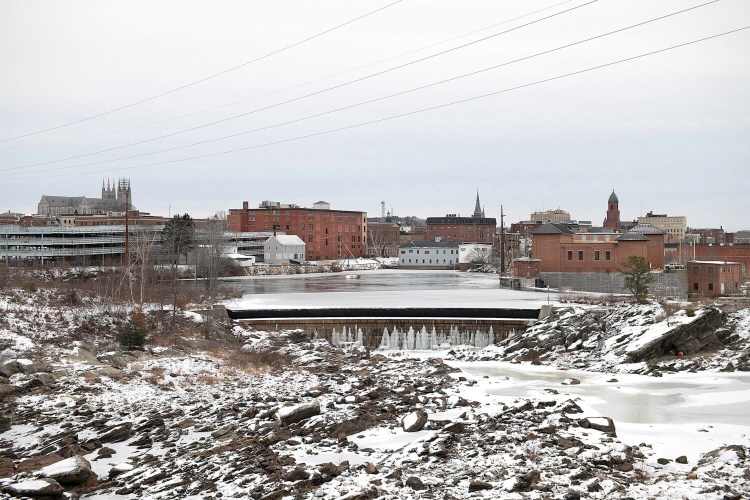LEWISTON — The cities of Lewiston and Auburn, in conjunction with four other stakeholders, have requested that the owner of the Lewiston Falls Hydroelectric Project conduct studies on the aesthetics, recreation and water quality impacts of the dams as part of the project’s extensive relicensing process.
City planners say this is a once-in-a-career opportunity to encourage waterfront revitalization and influence the project’s license agreement, which was last issued in 1986 and expires in 2026.
Ultimately, the Federal Energy Regulatory Commission will make the final decision on which studies Brookfield White Pine Hydro, the owner, must complete during the relicensing process.
“Both communities are looking to take this opportunity to make sure that everything is taken into consideration to the greatest extent possible with potential studies that may result in mitigation measures that will benefit both communities from an economic development perspective, from a livability perspective, (and a) water quality perspective,” Lewiston Director of Planning and Code Enforcement David Hediger said.
The cities, in partnership with American Whitewater, Trout Unlimited, Grow L+A, and the Appalachian Mountain Club, compiled the requested studies and additional comments on the Lewiston Falls project, aiming to restore the natural beauty of the Androscoggin River and improve downtown recreational opportunities, drawing more activity to the waterfront.
“We have found in the past … that if different groups of stakeholders are asking for different things that may even compete with each other, that will be used to the advantage of the license applicant,” Auburn Director of Planning and Permitting Eric Cousens said. “We had decided early on that our best chance for being successful in that licensing process was to talk among the various stakeholders and try to agree on what we were asking for.”

A map of the Lewiston Falls Hydroelectric Project. Main Street in Lewiston is located in the bottom right corner. Brookfield pre-application document map
Located above the Great Falls between Lewiston and Auburn, the Lewiston Hydroelectric Project is comprised of five dams, which were originally built in the 1860s to control water flow through the canals and power Lewiston’s now-shuttered mills. Today, the project primarily serves to generate electricity.
“The hydro facility has lost its historic economic connection to the community and no longer powers the idle mills and canals, but it continues to impact the communities by severing access and redirecting flows from public trust resources and by hampering recreational activities,” the study request document states. “If the dam is relicensed, Brookfield White Pines Hydro must compensate the owners of the river, the citizens of Lewiston and Auburn and of the State of Maine, for their loss of the use of it in its natural state.”
Brookfield did not respond to an emailed request for comment Monday.
Cousens said he believes it is almost certain that the dam will be relicensed. The Lewiston Falls project is authorized to produce 24.44 megawatts of electricity each year, the seventh highest hydroelectric production capacity in the state.
“This is a profitable dam,” he said. “I don’t even think (removal) is a possibility in the FERC process, I think that the facility makes enough money that it will be worth their while to mitigate their impacts.”

Brookfield will undergo a relicensing process for the Lewiston Falls Hydroelectric Project, a series of dams at the Great Falls between Lewiston and Auburn. Daryn Slover/Sun Journal
One of the stakeholders’ primary concerns is the visual impact of the Lewiston falls project. According to data in the document, flows over the Great Falls have been reduced by 40% since the Charles E. Monty Station powerhouse was opened in 1990. Now, water flows over the falls just one in 10 days of the year.
“The lack of water reveals the permanent scar of the raceway, the dry rocks of Lewiston Falls have attracted graffiti and trash, the lack of water flow in the canal system invites litter and imparts a sense of stagnation,” the document states. “Until the visual impact changes, Lewiston-Auburn cannot meet its full potential as a vibrant urban center focused on its riverfront.”
Stakeholders believe that recreational opportunities, too, have been negatively impacted by the dams. Through-paddling is limited by the dams and lack of portage, and the 2.5 mile long impoundment above the dams flood the natural floodplain, creating steep, inaccessible banks and making it difficult to access the water, they wrote.
They proposed a study to evaluate river access and flow to inform future development and recreation projects near the river and canals. This is of particular importance, they argue, because of the high poverty rate in the Lewiston-Auburn communities. Forty percent of downtown residents do not own a car, and there are few other recreational opportunities in walking distance, according to the document.
Additionally, stakeholders requested that Brookfield monitor the water quality below the Lewiston falls to “gather data on the effects of water releases over the falls as opposed to through-run through the turbines.”
Send questions/comments to the editors.




Comments are no longer available on this story